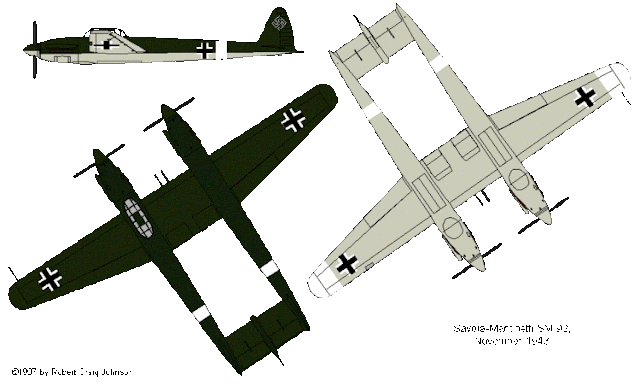Il Savoia-Marchetti S.M.92 era caccia bimotore bifusoliera ad ala media realizzato dall'azienda italiana Savoia-Marchetti negli anni quaranta e rimasto allo stadio di prototipo.
Destinato ad essere proposto per l'utilizzo da parte della Regia Aeronautica durante la seconda guerra mondiale, a causa delle vicende belliche a seguito della firma dell'armistizio di Cassibile, venne valutato dalla Luftwaffe ma non ebbe un seguito produttivo.
Storia
Sviluppo
Sebbene il precedente S.M.91 si fosse dimostrato completamente soddisfacente nelle prove, i tecnici della Savoia-Marchetti erano all'opera per migliorarne le prestazioni. Poiché non era possibile un incremento della potenza dei motori (il Daimler-Benz DB 603 da 1 550 CV non era ancora disponibile per le industrie italiane) la riduzione di peso sembrava l'unica via possibile.
Mantenendo gli stessi motori dell'S.M.91, l'ala di base ed il disegno della coda, i progettisti abbandonarono la gondola centrale e disposero l'equipaggio nella fusoliera di sinistra, dando all'aereo un aspetto "asimmetrico".
L'armamento era costituito da due cannoncini MG 151/20 da 20 mm installati sul bordo principale della sezione centrale, un terzo sulla semiala sinistra e due mitragliatrici sincronizzate Breda-SAFAT da 12,7 mm sotto ogni motore.
Il ruotino di coda si ritirava in una baccello posto sulla linea centrale dello stabilizzatore orizzontale. Una mitragliatrice Breda-SAFAT da 12,7 millimetri, manovrata a distanza, era montata nella parte posteriore di questo baccello.
Impiego operativo
Il prototipo del velivolo venne testato due mesi dopo l'armistizio di Cassibile, durante il periodo di occupazione tedesca. Portato in volo per la prima volta il 12 novembre 1943 ai comandi del comandante Aldo Moggi e con la presenza a bordo del motorista Carlo Balzarini dal campo di aviazione di Vergiate, recava le insegne della Luftwaffe.
I collaudi proseguirono fino all'anno successivo quando, a causa di un'errata interpretazione del pilota, venne attaccato dal Macchi M.C.205 ANR del tenente Mazzei della Squadriglia complementare d'allarme "Montefusco". Mazzei era decollato con il maresciallo Ennio "Banana" Tarantola dall'aeroporto di Venaria Reale ed avendo notato la configurazione bifusoliera lo aveva scambiato per un Lockheed P-38 Lightning alleato.
I danni conseguiti ai motori costrinsero il pilota ad un atterraggio di fortuna sul campo di Lonate Pozzolo il quale, benché autore di un fuori pista, riuscì a non procurare al velivolo danni tali da impedirne il ripristino. Dopo le necessarie riparazioni riprese le prove di volo nel giugno 1944 accumulando in totale 21 ore.
L'unico esemplare realizzato rimase distrutto, assieme all'S.M.91, durante l'azione di bombardamento USAAF del 27 dicembre 1944 che interessarono l'abitato di Vergiate e gli stabilimenti Savoia-Marchetti.
Utilizzatori
- Germania - Luftwaffe.
ENGLISH
The Savoia-Marchetti S.M.92 was a medium-wing twin-engined twin-engine fighter built by the Italian company Savoia-Marchetti in the 1940s and remained at the prototype stage.
Destined to be proposed for use by the Regia Aeronautica during the Second World War, due to the war events following the signing of the Cassibile armistice, it was evaluated by the Luftwaffe but had no productive follow-up.
History
Development
Although the previous S.M.91 had proved completely satisfactory in the tests, the Savoia-Marchetti technicians were working to improve its performance. Since an increase in engine power was not possible (the 1 550 hp Daimler-Benz DB 603 was not yet available to Italian industries) weight reduction seemed the only possible way.
Keeping the same engines as the S.M.91, the base wing and tail design, the designers abandoned the central gondola and placed the crew in the left fuselage, giving the aircraft an "asymmetrical" appearance.
The armament consisted of two 20 mm MG 151/20 guns installed on the main edge of the central section, a third on the left wing and two synchronized Breda-SAFAT machine guns of 12.7 mm under each engine.
The tail wheel retreated into a pod located on the centerline of the horizontal stabilizer. A 12.7mm Breda-SAFAT machine gun, remotely operated, was mounted at the rear of this pod.
Operational use
The prototype of the aircraft was tested two months after the Cassibile armistice, during the German occupation. Brought into flight for the first time on November 12, 1943 at the controls of Commander Aldo Moggi and with the presence on board of the motorist Carlo Balzarini from the airfield of Vergiate, it bore the insignia of the Luftwaffe.
The tests continued until the following year when, due to a misinterpretation of the pilot, he was attacked by the Macchi M.C.205 ANR of Lieutenant Mazzei of the complementary alarm squadron "Montefusco". Mazzei had taken off with Marshal Ennio "Banana" Tarantula from Venaria Reale airport and having noticed the bifurcated configuration had mistaken him for an allied Lockheed P-38 Lightning.
The damage to the engines forced the pilot to make an emergency landing on the Lonate Pozzolo field which, although he had made an off-run, he managed not to cause such damage to the aircraft that it could not be restored. After the necessary repairs, he resumed flight tests in June 1944, accumulating a total of 21 hours.
The only specimen realized remained destroyed, together with the S.M.91, during the USAAF bombardment action on December 27, 1944 that involved the town of Vergiate and the Savoy-Marchetti factories.
Users
- Germany - Luftwaffe.
(Web, Google, Wikipedia, You Tube)
















Nessun commento:
Posta un commento
Nota. Solo i membri di questo blog possono postare un commento.